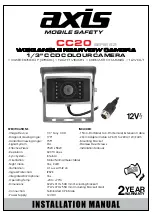
12
Installation & Operation Guide: Oncam Grandeye 360
o
Evolution Camera Range
Version 2.4 | January 2014 | Oncam Grandeye, 115 Hammersmith Road, London. W14 0QH. UK
T: +44 (0)20 7371 6640 | E: [email protected] | W: www.oncamgrandeye.com
3.6
Positioning Multiple Cameras
For more detailed surveillance of a large area, add cameras every 9 to 15 metres (30 to 50 feet) to form overlapping
circles of coverage.
3.6.1
Indoor Placements
Ceiling mounted cameras should be high enough to get an overview of the room, but not so high as to be away
from the action. A height of 2.7 to 4.6 metres (9 to 15 feet) above the ground is ideal for most commercial buildings.
Go higher for large auditoriums, lobbies and malls.
Wall mounted cameras should be low enough to fill the image, but not so low as to be obstructed. Try to avoid
capturing too much ceiling in your shot.
3.6.2
Outdoor Placements
With ceiling or pendant mounted cameras, generally the higher you can mount the camera, the more area it will
cover. Watch out for bright light sources – it is better to be below them than above. Mount at least 4.6 metres (15
feet) above ground to avoid vandalism.
For wall mounted cameras, mount at 3.7 to 4.6 metres (12 to 15 feet) above street level, possibly under an eave.
Avoid direct sunlight; northern exposures are preferable
3.7
Lighting Recommendations
Auto sensor adjustment works best for nearly all environments. The camera continuously adjusts the exposure to
optimise the image. Night mode drops the frame rate in half and doubles the exposure time. The image is rendered
in black and white for better contrast. Motion
‐
sensing lights may be used to illuminate the scene: The camera will
quickly adjust when lights turn on.
3.7.1
Lighting tips
There are settings within the camera’s web pages which will allow the camera to be used in a wide range of
applications and lighting conditions
Image controls include: Brightness / Contrast / Saturation













































